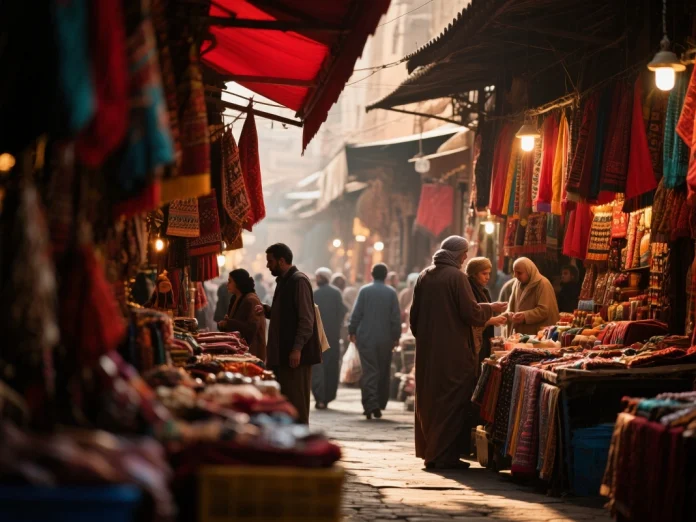Are you tired of the predictable, air-conditioned corridors of modern shopping malls? Do you crave a more authentic, sensory-rich experience when you shop? If so, it’s time to turn your back on the glass-and-steel monoliths and step into the vibrant, chaotic, and utterly enchanting world of traditional bazaars. More than just places to buy things, these ancient marketplaces are living, breathing entities—the true soul of a city.
The battle between the old and the new is a tale as old as time, and in the world of retail, it’s a showdown between the souk and the superstore. While modern malls promise convenience, efficiency, and a sanitized shopping experience, traditional bazaars offer something far more profound: a connection to history, a celebration of culture, and a deep sense of community. This article is your guide to understanding why traditional bazaars are not just surviving in a digital age, but thriving, offering an experience that no algorithm or corporate brand can ever replicate.
A Symphony for the Senses
Step into a traditional bazaar, and you are immediately overwhelmed in the best possible way. The experience is a full-body immersion. The air is thick with the scent of exotic spices—cinnamon, saffron, cumin, and cardamom—blending with the sweet aroma of local pastries and the earthy smell of hand-woven fabrics. The sounds are a cacophony of life: the friendly chatter of vendors calling out their wares, the rhythmic clang of a coppersmith, the excited laughter of children, and the melodic strains of traditional music wafting from a distant stall.
Compare this to the sterile silence of a mall, broken only by generic pop music and the hum of escalators. A mall is designed to be a controlled environment, devoid of surprises. A bazaar, on the other hand, is an adventure. Every corner holds a new discovery, every turn introduces you to a new character, and every scent tells a story. This sensory richness is a key reason why traditional bazaars leave such a lasting impression. They engage more than just your wallet; they engage your mind, your heart, and your senses.
The Art of the Haggle: More Than a Transaction
One of the most defining features of a traditional bazaar is the art of haggling. For the uninitiated, it might seem like a daunting or even uncomfortable process. But for those who embrace it, haggling is a delightful dance, a friendly negotiation that is as much about human connection as it is about price. It’s a chance to interact directly with the person who made the product or who has dedicated their life to their craft.
In a mall, you walk in, look at a price tag, and pay. There’s no conversation, no human element. In a bazaar, a successful negotiation isn’t just about saving a few dollars; it’s about building a relationship. It’s a moment of shared laughter, a sign of mutual respect, and a testament to the fact that you’re dealing with a real person, not a faceless corporation. This personal connection transforms a simple purchase into a memorable interaction, something that a self-checkout machine can never replicate.
Authenticity at Your Fingertips
While modern malls are filled with global brands and mass-produced goods, traditional bazaars are a treasure trove of authenticity. Here, you’ll find artisanal goods crafted with centuries-old techniques, from intricate hand-carved furniture and delicate pottery to vibrant textiles and unique jewelry. Many of these items are one-of-a-kind, each with its own history and story.
This authenticity extends beyond the products to the people themselves. The vendors are often multi-generational shopkeepers, their stalls passed down from their parents and grandparents. They are not just salespeople; they are storytellers, historians, and experts in their field. They can tell you about the origins of the spices, the meaning behind the patterns on a rug, or the history of a particular piece of jewelry. This deep knowledge and passion are what make shopping at a bazaar a truly educational and enriching experience.
The Hub of Community
Beyond commerce, traditional bazaars have always served as the beating heart of a community. They are a place for people to gather, to socialize, and to share news. They are the stage for daily life, where friendships are forged over a cup of tea and a shared laugh. This sense of community is palpable. You see neighbors catching up, families shopping together, and people from all walks of life interacting in a way that is increasingly rare in our digitized world.
Contrast this with the atomized experience of a mall, where people often move in silent, isolated bubbles. A mall is designed for consumption, not for connection. A bazaar, however, is a microcosm of society, a place where the rich tapestry of a city’s culture is on full display.
Why the Bazaar is a Sustainable Choice
In an era of growing environmental consciousness, they offer a compelling, sustainable alternative to modern retail. Most goods sold in bazaars are locally sourced and handmade, with a much smaller carbon footprint than products that are mass-produced in distant factories and shipped halfway around the world. The business model supports local artisans and small-scale farmers, ensuring that wealth circulates within the community rather than being siphoned off by multinational corporations. By choosing to shop at a bazaar, you are not just buying a product; you are investing in a community and supporting a more sustainable way of life.
Conclusion: Beyond Shopping, It’s an Experience
The modern shopping mall has its place, offering convenience and a climate-controlled escape. But it can never replicate the magic, the soul, and the sheer vitality of a traditional bazaar. Bazaars are more than just places to shop; they are living museums, cultural hubs, and vibrant expressions of a city’s identity. They offer a journey through history, a feast for the senses, and a genuine connection to people and place.
So the next time you’re looking for something unique, something with a story, skip the sterile storefronts. Step outside, follow the sounds and smells, and allow yourself to get lost in the labyrinthine alleys of a traditional bazaar. You’ll not only find a souvenir, but you’ll also find a story, a memory, and a piece of the city’s soul.



